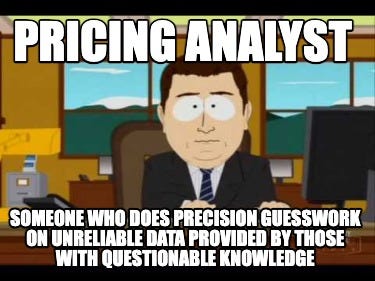A primer on product pricing
What's your current org's pricing maturity? How can you determine the user's price sensitivity? How does one build a value-based pricing strategy? + An actionable tool for price prediction.
Hi and welcome to the Corporate Waters weekly newsletter 🙌
I’m Mikhail and I'm excited to share my learnings to help you navigate the murky waters of product management, leadership, and corporate dynamics. Subscribe to unlock the full value.
In today’s paid newsletter:
(Free) How to tell what’s your org pricing maturity and user price sensitivity;
(Paid) Pricing strategy and it’s key building blocks;
(Paid) Methodology for value-based price prediction + our learnings (with a downloadable template).
A few years back, I knew little about pricing. My understanding was limited by the textbook principles of supply/demand and elasticity. This changed when I joined Bolt. As the internal saying goes - at Bolt, one year runs like two. A similar thing can be said about my exposure to pricing.
In the past, our team at Rentals was at a crossroads. We were no longer infants, relying on costs and guesswork, but we weren’t mature enough for value-based pricing. A significant portion of our decision-making was influenced by competition. We thought, “Those guys hiked their base price to X cents per minute, heck, we need to react quickly if we don't want to lose demand”.
Market-based pricing works, but it can hardly be called a strategy. Firstly, you are making tactical decisions in response to market changes. Secondly, in many cases, you disregard profit targets. Thirdly, there are usually alternatives outside the narrow scope of competition. As for the competition, you never know what they are smoking and how rational their pricing is.
In our case, a turnaround was needed to transition from reactionary to anticipatory price management. The story below is about how we did it and what we learned along the way. By no means do I claim to be an expert on pricing. Article is titled “a primer” purposefully, as pricing is an incredibly deep and multidimensional topic that cannot be compressed in a single post. The goal for me is to share a set of actionable and non-trivial insights from our pricing transformation journey.

💰🔝 Pricing Maturity
Typically, pricing maturity correlates with the maturity of the organization. When you start building an early-stage startup, there are three ways pricing is done - guesswork, cost-based, or competitor-driven pricing. It's completely acceptable, because you have little demand and price elasticity history from your users to make true value-based predictions.
As your company grows, you acquire more data and resources to hire analytical talent. Not to mention the pressure from competition. Combined, these factors pave the way towards a value-based pricing strategy. In a nutshell, you stop comparing your offer to the competition or the latest buyer demand figures, and instead build a model that allows you to predict and optimize for maximum profit based on historical data.
Of course, this is an ideal scenario. Just like people, organizations can skip some steps in their developmental process and exhibit childish tendencies at a very advanced stage. But let’s not dwell on the corner cases.
📈🔄 Market Stages
Another variable that drastically impacts price sensitivity is the market lifecycle stage. If you launch a new “blue ocean” innovative product, there usually aren’t any price benchmarks to compare against. User’s price sensitivity is virtually non-existent or very low.
An example is the paid version of ChatGPT Plus. What do you compare it against? Of course, you can try to go rogue, download, and deploy a freeware alternative to GPT4 from Hugging Face. However, I doubt an average user will be able to make sense of the token and GPU costs required to run this operation. At this stage of the market, you can price your product to cover all the costs plus a premium that’s not too far off in terms of common sense.
In the market growth stage, competition is booming, and there are already some alternatives. One market that comes to mind is plant-based foods. It’s not just Beyond Meat's dominance anymore. You can get vegan burger patties from a bunch of local producers. Different sizes, ingredients, flavors. The buyer has many price reference points now, leading to higher sensitivity. Why should I grill my burger for €3.99 a piece when there’s an equally filling alternative for €2.99?
Maturity comes with commoditization. When something becomes a commodity, price rules and sensitivity reaches its peak. I’d say at Rentals, e-scooters have become a commodity. Riders compare vehicle providers by price and choose the one that’s available in close proximity. Why would you ride with Lime when there’s a cheaper Voi alternative nearby?
There’s a later stage called decline when demand is diminishing while price sensitivity reaches its maximum peak (there are too many alternatives with equally low value). The question at this point is how to exit the market with the lowest possible losses.
🎯 Pricing Strategy
Once you build context and understand the stages of the market lifecycle and your organization’s pricing maturity, you can buckle up for a pricing strategy. Exclusive and actionable content below is available only for my paid subscribers.






